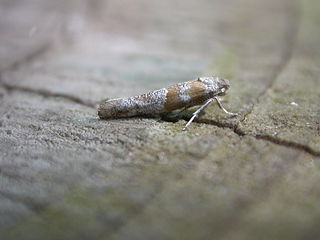Silvestri is a surname of Italian origin. Noted people with this last name include:

Filippo Silvestri was an Italian entomologist. He specialised in world Protura, Thysanura, Diplura and Isoptera, but also worked on Hymenoptera, Myriapoda and Italian Diptera. He is also noted for describing and naming the previously unknown order Zoraptera. In 1938 he was nominated to the Pontifical Academy of Sciences, the scientific academy of the Vatican.
The former Italian Catholic diocese of Alatri existed until 1986, when it was united into the diocese of Anagni-Alatri. Comprising historically seven towns close to Rome, it was under the immediate jurisdiction of the Holy See.

Cedestis gysseleniella is a moth of the family Yponomeutidae. It is found in Europe and parts of Russia.
Euarne is a genus of moths of the family Yponomeutidae. It is named after Euarne, one of Hesiod's 50 Nereids.

Prays is a genus of moths of the family Praydidae, formerly assigned to Plutellidae or Yponomeutidae.
Prays amblystola is a species of moth in the family Praydidae. It was described by Alfred Jefferis Turner in 1923 and is found in New South Wales, Australia.
Prays calycias is a species of moth in the family Praydidae. It was described by Edward Meyrick in 1907 and is found in Australia.
Prays inscripta is a species of moth in the family Praydidae. It was described by Edward Meyrick in 1907 and is found in Australia. The larvae feed on Phebalium plants.
Prays ducalis is a species of moth in the family Praydidae. It was described by English entomologist Edward Meyrick in 1914 based a single specimen collected in Sri Lanka.
Prays erebitis is a species of moth in the family Praydidae. It was described by English entomologist Edward Meyrick in 1914 based on two specimens collected in Ootacamund, India.
Prays friesei is a species of moth in the family Praydidae. It is found on the Canary Islands and Madeira. The larvae feed on Chrysojasminum odoratissimum and Picconia excelsa.
Prays fulvocanella is a species of moth in the family Praydidae. It is endemic to the Hawaiian island of Kauai. Species of Melicope and Zanthoxylum may serve as hosts for P. fulvocanella larvae.
Prays liophaea is a species of moth in the family Praydidae. It was described by English entomologist Edward Meyrick in 1927 based on two specimens collected from Stellenbosch, South Africa.
Prays peperitis is a species of moth in the family Praydidae. It was described by English entomologist Edward Meyrick in 1907 based on seven specimens collected in Sri Lanka.
Prays xeroloxa is a species of moth in the family Praydidae. It was described by English entomologist Edward Meyrick in 1935 based on larvae collected from the island of Java and reared on Harrisonia leaves.

Praydidae is a family of false ermine moths in the superfamily Yponomeutoidea. Though once considered a subfamily (Praydinae), a 2013 molecular analysis elevated it to family rank.
Metriochroa inferior is a moth of the family Gracillariidae. It is known from Eritrea.
Carposina chersodes is a moth in the family Carposinidae. It was described by Edward Meyrick in 1915. It is found in Eritrea.
Criticism of pandeism has been carried out in various ways by proponents of other theological models, particularly of atheism and theism. Proponents of pandeism have themselves published collections containing criticism from various viewpoints, including those written from Christian, Jewish, Islamic, New Thought, and Atheist perspectives, as part of efforts to increase awareness and debate regarding Pandeism. At times, ideological foes have accused political and religious figures of secretly being pandeists, as a means of casting aspersions on those accused.



